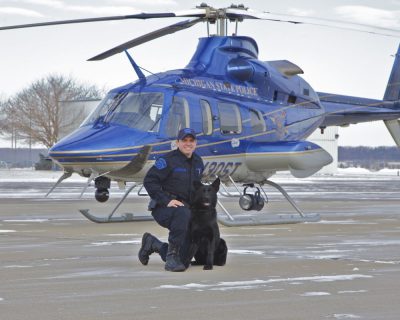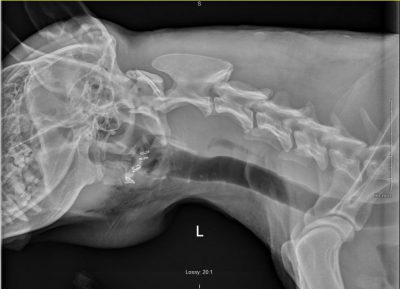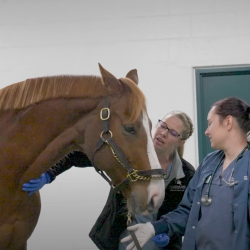By David Upchurch, DVM, MS, DACVS-SA
History and Diagnosis

Bolt, a 7-year-old, intact male German Shepherd dog presented to the MSU Veterinary Medical Center after having suffered a stab wound. Bolt is a veteran officer in the Michigan State Police (MSP) Canine Unit. MSP canines are trained to track wanted or missing persons by following human scent. They can do so by following a track or by locating specific airborne scents. They also are taught to defend themselves and their handlers in situations where the likelihood of serious injury to a police officer or another person is imminent.
On the morning of the emergency visit, Bolt and his handler were called to assist in tracking two individuals wanted in connection with a drive-by shooting. The suspects had eluded police by entering a wooded area on foot. Bolt was able to track the suspects for more than one mile. When one of the suspects attempted to flee, Bolt and other officers pursued.
As Bolt restrained the subject while the human officers arrived, his handler heard him yelp. After the suspect was detained, it was noted that Bolt had a wound on the side of his neck, most likely caused by a pocketknife that had been discarded by the suspect during the altercation. The wound was initially assumed to be minor because it stopped bleeding. However, as Bolt and his handler were responding to another incident a short time later, the wound began bleeding again continuously.
Bolt was brought to the Animal Emergency Hospital of Rockford, Michigan, where he was assessed by Dr. Marilyn Brink and the other veterinarians on staff. They noted that Bolt had a one-inch laceration on the right side of his neck. While the wound itself was slowly dripping blood, a more concerning finding was a one-inch-wide swelling underneath the jaw, just in front of and below the wound. This was determined to most likely be a hematoma, indicating that the bleeding was likely worse than what could be seen externally.
A surgical exploration of the wound was recommended to find the source of the bleeding. The emergency clinic treated Bolt with buprenorphine and carprofen to keep him comfortable and Clavamox to help prevent the wound from getting infected. They cleaned the wound and closed it temporarily with skin staples. They also placed a bandage around his neck to help slow the bleeding. Afterward, Bolt was referred to MSU to have the wound explored and the cause of bleeding addressed.
On presentation to Dr. Tereza Stastny at MSU’s Emergency and Critical Care Service, Bolt was quiet, but alert and responsive. His temperature, heart rate, and respiratory rate were all within normal limits. Cardiopulmonary auscultation revealed no abnormalities. Upon removing the bandage on his neck, it was noted that the swelling had doubled in size and was now accompanied by significant bruising.
Treatment and Outcome

Concerned that Bolt may have suffered damage to other structures in his neck, such as his trachea or esophagus, cervical radiographs were performed. The radiographs showed swelling of the soft tissues along with some gas, likely let in through the penetrating wound. Fortunately, no damage to deeper structures was suspected.
After Bolt was sedated, the fur around his wound was further clipped. This not only prevented bacteria and contaminants in his fur from entering the wound, but also allowed the doctors to look for any other wounds in the area that may have been hidden by the fur. The wound itself was thoroughly lavaged with sterile fluid to remove any debris and bacteria from the area. Although no blood was noted to be coming from the wound, the team made a small incision to the swollen area to allow any fluid within to drain out. Fortunately, the bleeding was minimal. A bandage was placed on the wound overnight and a surgical exploration of the wound was scheduled for the next morning.
Bolt was placed under anesthesia for the surgical exploratory procedure. The initial wound was enlarged to allow more thorough assessment. The underlying tissues appeared healthy in general, and a large amount of clotted blood was noted in the swollen area underneath the jaw. The clotted blood was removed, and no ongoing bleeding or damage to any vital structures was noted. Samples from the wound were taken for bacterial culture and susceptibility. After the wound was lavaged again, a drain was placed and the wound was closed. The Jackson-Pratt drain used allowed fluid from the wound to be removed through a tube placed into a canister that Bolt wore on his collar. This allowed closure of the wound without worries that fluid would continue to accumulate under the skin and potentially form an abscess.
Bolt recovered well from his surgery and was sent home the next day with pain medications, antibiotics, and instructions on how to care for the wound using the drain. The drain production decreased enough that it was able to be removed after three days. After two weeks, the incision had fully healed and the skin sutures were removed. At that time, Bolt appeared to have made a full recovery.
Comments
Cervical wounds are common injuries in dogs. The most common causes are a result of bite wounds or road traffic accidents, although police and military working dogs are at increased risk of gunshot and stab injuries. The initial cause of a wound influences the management strategies used. When a dog bite or road traffic accident occurs, the tissues damaged are typically crushed. Crushed tissue may initially appear viable, but can begin to show signs of necrosis more than 24 hours later. As a result, these wounds often have to be left opened and bandaged for several days. Sharp penetrating wounds do not cause as much crushing injury, but the visible wound may hide damage to deeper structures.
In the case of a stab wound to the neck, damage can easily occur to several important structures, including the trachea, larynx, esophagus, carotid artery, jugular vein, mandibular salivary gland, thyroid or parathyroid gland, or even the spinal cord. Failure to diagnose damage to these structures can lead to severe and life-threatening complications including respiratory compromise, neurologic disease, bacterial contamination of the neck (leading to life-threatening sepsis), or persistent bleeding. Many wounds will stop bleeding as the body’s natural coagulation process begins to work.
In addition, blood that accumulates in the tissues around the vessel can put pressure on the vessel that decreases or stops bleeding. However, the large vessels in the neck may not coagulate as quickly as smaller vessels elsewhere, leading to ongoing bleeding that may persist indefinitely. In addition, the loose connective tissues of the neck do not serve as an effective way of containing blood. As a result, the blood can disperse throughout the entire neck region, even into the submandibular region or as far back as the chest. This results in the bleeding vessel not having significant pressure on it.
Fortunately, Bolt’s injuries were not severe. Through a combination of wound management and surgical exploration, veterinarians were able to ensure that there was no concerning or lasting damage.
Dogs in service professions like Bolt put their lives on the line to help protect civilians and human officers alike. This means that they are at higher risk than the average dog of suffering trauma such as gunshots or stabbing. The staff of MSU are always fortunate to be able to provide care for these heroic canines when they are in need of it, and are always happy when the outcome is positive, as it was in Bolt’s case.



